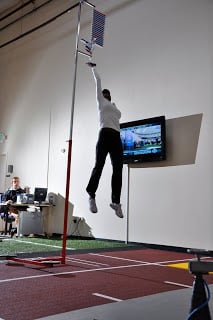
Ranging from SPARQ testing at high school showcases to genetic analysis, athletes, parents, and coaches are constantly striving to identify athletic potential and physical talent. While most of these tests provide poor insight into athletic success, vertical jump stands alone as one of the more comprehensive measures.
Sprint tests are good; they measure how quickly an athlete pushes into the ground to propel themselves forward. Agility movements are also good as they gauge how smoothly athletes can slow down to stop before accelerating in a different direction. However, both of these tests are skills, the more they are practiced, the more efficient the execution becomes, resulting in faster times.
Have you ever seen a baseball player run agility compared to a soccer player? How about a volleyball player sprinting next to a football player? Such horrifying images are eliminated by choosing a test that can be more easily compared across sports. Vertical jump is a much simpler movement that can be mastered even by a beginner. Such a basic test allows coaches to better separate the skill from raw physical ability.
The other advantage of a vertical jump is that it combines the two aforementioned qualities of a sprint (quick) and agility (smooth). Ideally, athletes quickly load the vertical jump on their downward descent, before smoothly stopping and using this energy to accelerate upwards to jump.
At Sparta, we use a force plate to identify which aspects of the vertical jump must be improved before customizing a training program to target such weaknesses. By individualizing their needs we can both dramatically increase the jump height (up to 5 inches in a month!) and reduce injury rates by attacking their weakness.
Since you don’t have a force plate, there are ways to still improve your vertical jump. Perhaps the best movement is the Front Squat, as this exercise targets the quadriceps, the muscles involved most when an athlete jumps upwards. While plyometrics (jumping exercises) can also improve your jump, athletes involved in jumping sports (basketball, volleyball, etc.) should avoid adding more jumps to their regimen as practice and games will suffice.